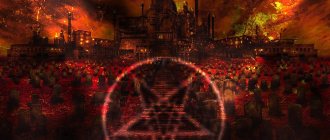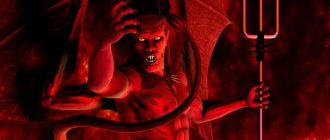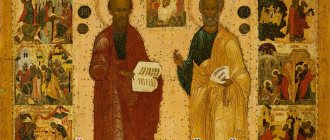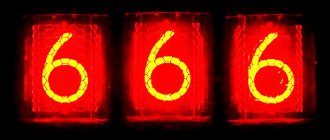Telegram channel @ieshua.org
Satan. What images does this word conjure up in your mind? An evil creature with horns, a tail and a pitchfork? A cute baby in a red hood on your doorstep on Halloween? Cultural caricatures aside, Satan is a concrete and real being known to Christians as the great liar and deceiver, the sworn enemy of God and His people. Scripture has a lot to say about his character and actions—who he is and what he does—but what about his background? Where did he come from? Who created the devil?
Chatty snake
The Bible opens with the story of creation, when God announced the beginning of the universe. The first two chapters present breathtaking pictures of order, wholeness and prosperity. It is not surprising that the Creator, having surveyed what He had created, declared that it was all “very good” (Gen. 1:31).
And suddenly, unexpectedly, a snake appears. But this is not just an ordinary snake: he talks, and I must say that he is very talkative. Very quickly, this writhing creature begins a conversation with Eve, seducing her and her silent husband - and you and me - into rebellion against God. As the story progresses, it becomes clear that this ancient serpent is the embodiment of Satan himself (Rev. 12:9).
Origin of the Devil
The Bible does not explicitly and clearly describe the origin of Satan. Presumably, he began to exist some time after God created the perfect world (Gen. 1:31) and before his appearance in the Garden of Eden in the form of a serpent (Gen. 3:1). Despite everything we don't know, we can say with some certainty at least the following five things.
God created him.
Scripture states that everything was created by God and for God (Rom. 11:36; 1 Cor. 8:6; Col. 1:16-17). It naturally follows that the all-encompassing category of “everything” even includes the devil. After all, if God is not “behind” the creation of Satan, then who is? Some other powerful being? If so, then this being must control at least one realm of existence. And then this sphere cannot be completely subject to God and be under His control.
God created him kind and good.
As the source of all goodness, beauty, and truth, God creates only that which is consistent with His nature—things that are in themselves good, beautiful, and true. Every aspect of creation, whether in heaven or on earth, was originally “very good.” Paul puts it simply: “Every creation of God is good” (1 Timothy 4:4). God's character is one of perfect purity; there is not even an iota of darkness or deception in Him (1 John 1:5; James 1:13). And Satan was created as an angel to serve and glorify this great God.
Obviously something went wrong.
Some of God's created angels rebelled against Him.
There are two places in the New Testament that speak of a time when angels rebelled against God and fell into evil and darkness:
God did not spare the angels who sinned, but, having bound them in the bonds of hellish darkness, he handed them over to be judged for punishment. (2 Peter 2:4)
The angels who did not retain their dignity, but left their home, are kept in eternal bonds, under darkness, for the judgment of the great day. (Jude 1:6)
According to Scripture, one day there was a rebellion of angels against the King of Heaven.
Satan has power in the realm of demons.
As the “prince of demons,” it was most likely Satan who initiated and led this heavenly rebellion (Matt. 12:24). And then, Satan is the first sinner, “for the devil sinned first” (1 John 3:8).
Satan's position as the head of the demonic forces is beyond doubt. Scripture calls him “the evil one” (Matt. 13:19), “the prince of this world” (John 12:31), “the god of this age” (2 Cor. 4:4) and “the prince of the power of the air” (Eph. 2:2). We see him initiating attacks on God's people (Job 1:6; 1 Chron. 21:1; Zech. 3:1) with "authority" and force (Acts 26:18) to "bind" (Luke 13 :16) and “possess” (Acts 10:38).
Michael Horton explains: “Fallen angels are not treated as creatures of evil by nature, but as followers of Satan in his rebellion. One day, the most glorious and powerful angel, Satan, was filled with pride and attempted a heavenly coup.”
Satan's evil manifested itself from within himself.
There was no one to tempt Satan into sin; his evil rose from within himself. It is not surprising then that Jesus calls him “the father of lies” and “a murderer from the beginning” (John 8:44) - these words echo even at the beginning of history.
Young Satan
It is noteworthy that Moses literally did not mention anything about Satan in his books. The latter can only be discerned in the image of the serpent that tempted Eve in the Garden of Eden, but the word “Satan” is not used. Moses composed his inspired books, apparently, in the now dead Phoenician language. At that time, Hebrew proper did not yet exist, and the Jews used the common Semitic language, which can conventionally be called Phoenician.
Thus, we must fix an important feature: the category of Satan in the sacred texts appeared explicitly, apparently, no earlier than the turn of the second and first millennia BC, when the Jews, through the prophet Samuel, asked God to give them a ruler-warrior like the pagan Philistines , in order to better organize protection against the latter.
In other words, “Satan” itself is only about 3 thousand years old, while, according to archeology, people with modern appearance and internal structure (Cro-Magnons) have existed for about 40 thousand years. It also turns out that Satan (his description in the sacred texts) is “younger” than the Abrahamic God by about a thousand years, and in comparison with the category of the Father-Creator, who created the world, according to more ancient religious systems, he is generally a snotty youth. But is this really so?
Satan has other names: devil, Beelzebub, Lucifer, Baphomet, etc.
What about Lucifer?
There is a very likely allusion to Satan's fall from heaven in the book of Isaiah. When the prophet describes God's judgment on the king of Babylon, he uses language too grandiose to describe a mere man:
How you fell from the sky, Lucifer, son of the dawn! crashed to the ground, trampling the nations. And he said in his heart: “I will ascend into heaven, I will exalt my throne above the stars of God, and I will sit on the mountain in the assembly of gods, on the edge of the north; I will ascend above the heights of the clouds; I will be like the Most High.” But you are cast into hell, into the depths of the underworld. (Isa.14:11-15; parallel to Ezek.28:1-19)
In the King James Version of the Bible, "morning star" is translated as Lucifer, which means "light bearer." Although it is a common religious term, it is not found in most modern Bible translations.
It is impossible to say with certainty that this passage from the book of the prophet Isaiah is an allusion to the pride of Satan and his subsequent fall from heaven, but it is certainly possible.
In a dark forest, on a remote road
A dense and dark forest is a place that evokes fear even in modern people. Although we have much greater knowledge in the field of biology, physics and other scientific disciplines, in such an environment we cannot always find a suitable explanation for what is happening around us. Somewhere a branch creaked, something rustled in the foliage, some shadows moved. At the edge of consciousness the thought flashes that everything around simply lives its own life and we are not alone here. But it is quickly replaced by fear.
We are afraid of what we cannot see if we feel its presence. This is one of the body’s most important defense reactions, a reminder of danger. Whether it is natural or supernatural does not matter, we just need to be prepared for its appearance.
What kind of physics or biology is there when you definitely hear footsteps behind you? It could be the rustling of branches or a mouse sneaking in a pile of moss and plants - such explanations are the last to come to mind. The first will be fear. And imagination will complete the rest - and do a great job with it.
This is how werewolves and ghosts appear, and the devil haunts night travelers. And the story of one bearer of experience is immediately passed on from mouth to mouth by tens and hundreds of people, acquiring more and more new details. This makes fear common - and, on the one hand, attracts people to the Church, and on the other, pushes them to not the most pleasant actions. The conclusion suggests itself: if the devil was seen in the forest near our village, then he was there for a reason.
And the reason for the appearance of the unclean also lies on the surface - somewhere lives someone who is not indifferent to him. So it's time to look for the witch. And, of course, she will be found and judged - most likely, using the most far-fetched and formal pretext. But there will be no doubt, as well as the fact that it was the devil in the forest. Simply because it’s the 17th century, and knowledge in the field of natural science is at a primitive level. Especially among the peasants, most of whom don’t even know how to read.
This is how perhaps the most voluminous body of legends about the supernatural is formed.
In addition to visions of frankly diabolical origin, various local variations are also found here: English Black Dogs, legends about which are found with reference to almost half of the old villages of Foggy Albion; Stories about will-o'-the-wisps, luring travelers into swamps or simply flickering in the distance and causing horror, are almost ubiquitous in Europe. Werewolves and other ghouls scurry around here and there. And even the goblin, familiar to us from the Slavic tradition, fits into this concept just perfectly. Especially if we remember that he is also an otherworldly creature and clearly not of Christian origin.
Most stories of this kind boil down to the fact that someone somewhere saw something frightening. But sometimes more specific and detailed stories arose.
If you meet a dark silhouette moving towards you late at night on a forest road, it is scary. But if a meeting is inevitable, interaction is possible. This is how stories appeared about closer contacts between a person and evil spirits.
Of course, any respectable Christian in this case should start praying - and evil will pass by. But not every inhabitant of medieval Europe was a respectable Christian. Therefore, sometimes much more interesting plot development options arise.
For example, the devil (there is simply nothing else to do in the forest at night) may offer to go to a fair in a neighboring village - of course, sooner or later the hero realizes that the matter is clearly unclean, but it is too late. The devil takes him to a place from which they cannot return.
In other tales, the evil one offers a deal - for example, he is ready to correct (and as quickly as possible!) a situation that is bothering his interlocutor in exchange for some service. If he, in his simplicity and naivety, agrees, the devil may not remind himself at all for the rest of his life and only then will come to take him with him to hell. This should not be surprising - what else can you expect if you have contacted evil spirits.
An inventive enemy of the human race can, without any conditions, hand over something sacred: an impressive selection of occult literature, a wish-granting stone, or an elongated object of dubious origin that, if rubbed, causes two demons to appear and fulfill your every demand - but only once in a day. The last case at the end of the 16th century became the reason for a trial in France - as a result of which 350 people were found guilty.
Old questions
“There are two equal and opposite errors into which our human race falls in regard to demons,” writes C.S. Lewis in The Screwtape Letters. — One is not to believe in their existence. The other is to believe and have an excessive and unhealthy interest in them.”
We are in deep and mysterious waters, and there are many unanswered questions about which Scripture is simply silent. How could God's morally pure creation rebel against God? Why did other angels join the rebellion? When did all this happen?
And while Christians don't know all the answers, we know a God who has all the answers. And we know that “for this purpose the Son of God appeared, to destroy the works of the devil” (1 John 3:8).
If you follow King Jesus, take heart. Your enemy has been defeated (Col. 2:13-15), he is being defeated right now (Eph. 6:10-20), and he will be finally defeated (Rom. 16:20). Yes, he “walks about like a roaring lion, seeking someone to devour” (1 Peter 5:8), but the death of Jesus neutralized him, and the return of Jesus will destroy him.
In the meantime, its destructive influence extends only as far as the hand of God allows.
Author - Matt Smithurst / thegospelcoalition.org Translation -
Donate Last: 02/28. Thank you!
Subscribe: Telegram • Facebook • • • Twitter • Instagram • Youtube
Nasty Zeus-Baal
The modern word "devil" comes from the Greek "diavolos", which was used in Ancient Greece as the adjective "slanderous, slanderous, slanderer" or as the noun "slanderer". We find this word in these meanings in Pindar, Aristophanes, Menander and Aristotle. It is assumed that this word came from the Indo-European words “dia” (through, separately) and “balo” (throw, throw). At the same time, supporters of this etymology are not embarrassed by the fact that no actual meaning can be traced in it. How did “throwing separately” become “defamatory”? It’s not clear... And the thinkers named above lived in the middle and second half of the first millennium BC. What happened before? Was this word used? If used, in what sense? Many questions arise that have no answers.
This word can be looked at from the other side. The Greeks in the Mediterranean were in close, centuries-long trade interactions with the Phoenicians, whose male deity was Baal. The name of this deity appears to be closely related to the bull. Compare the words Baal, ox, bull (English bull). The bull in ancient non-literate cultures was used as an icon of the masculine deity (the Father-Creator who created the world). It is possible that the second part of the Greek word diabolus comes precisely through the Phoenician Baal from the bull as the personification of the ancient image of the Father-Creator. In the religions of more northern peoples, by the way, there are also equivalents to Baal: Veles, Volos, Tavr Busich, Tor (tur, taur (bull)), etc.
Then the first part of “dia” is simply read in meaning as “god” - deus (Zeus (Dy), Hindu Dyaus Pita (Heavenly Father), Roman Jupiter (Dews-pita)). The Greek god Dionysus, for example, also clearly has this first "dio" part, which can also indicate divinity. In the Roman tradition, Dionysus is called Bacchus (Bacchus), in whose name one can easily read the relationship with the Phoenician Baal.
If this assumption is correct, then the Greek word “diabolus” may have originally meant “the god Baal,” that is, a Phoenician god alien to the Greeks. Slanderous means deceptive, untrue, erroneous (one’s own god is always true, and someone else’s is false). And from these meanings, the meaning is very close to the meaning of “nasty, adversary, obstructor, obstacle,” that is, to the meaning of the word “Satan,” which comes from Hebrew, which was formed on the basis of the ancient language used by the Semites, including the Phoenicians. The circle is closed. In both cases, the tracks lead to the Phoenicians.
As for other names, the name “Baphomet” appeared in the Middle Ages, “Lucifer” - in the 8th century BC, and the Old Testament “Beelzebub” is the same Baal (Baal-Zebub, lord of the flies).
Thus, the “slanderous slanderer” the devil and the “obstructive adversary” Satan, having very ancient roots that were nourished by the same Phoenician soil, met in Christianity and have been inseparable since then. These words today denote an image that has the features of very ancient deities, the late pagan forms of which Jews and then Christians actively fought against.











